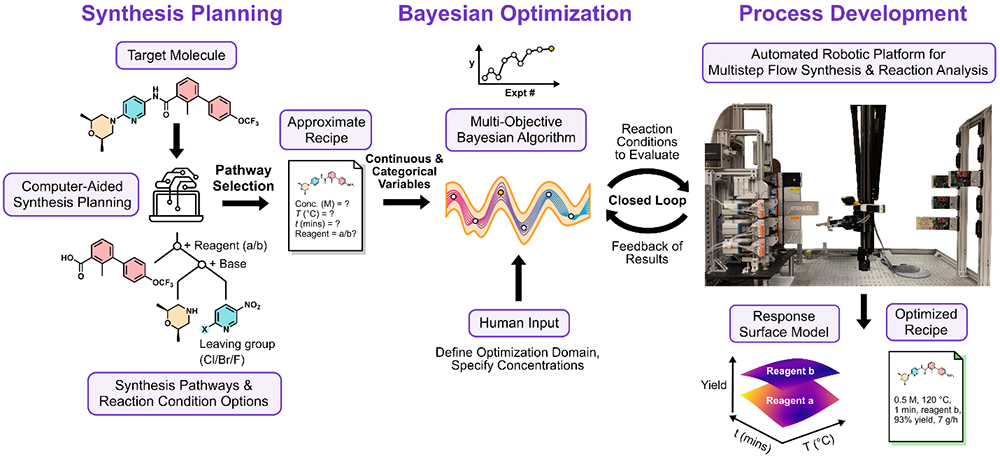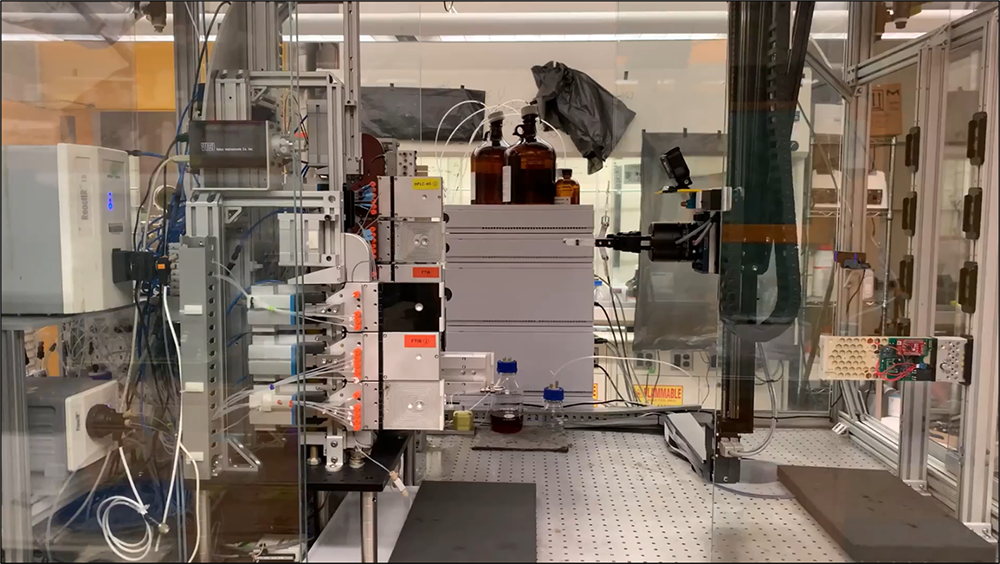We have had a continuing interest in planning and optimizing multistep flow synthesis. Our computer-aided synthesis planning (CASP) tools, specifically ASKCOS, can propose retrosynthetic pathways and forward reaction conditions for synthesizing organic compounds. Still, the limited availability of reaction context-specific data makes it challenging to suggest recipes specifying the sequence of unit operations and corresponding reaction conditions (e.g., concentrations, temperature, time, stoichiometry) without human intervention. We have leveraged human insights and algorithm-guided multistep reaction optimization as a tool to identify optimal process conditions for approximate synthesis recipes generated by ASKCOS. To enable these advances, we have upgraded our modular, robotic flow synthesis platform with process analytical technology (PAT) techniques, e.g., FTIR and HPLC/MS, for data-rich experimentation.
In a demonstration example, ASKCOS generated recommendations for synthesis routes and reaction conditions for the small molecule target, sonidegib. After a manual assessment of synthetic feasibility, human insights addressed catalyst deactivation and improved yield by strategic choices of the order of addition. Multi-objective Bayesian optimization identified optimal values for categorical and continuous process variables in the multistep route involving three reactions (including heterogeneous hydrogenation) and one separation. The platform’s modularity, robotic reconfigurability, and flexibility for convergent synthesis were essential to allowing variation of downstream residence time in multistep flow processes and controlling the order of addition, reducing undesired reactivity. We have also applied the multistep robotic platform to multistep photochemistry in flow and are currently exploring its use in electrochemistry.
The modular robotic platform also enables dynamic experimentation, allowing more efficient exploration of the underlying reaction space to extract kinetics and optimize performance than usual steady-state experiments. This data-dense method proves quicker than steady-state operations because of the increased amount of information collected during a single transient investigation. For example, the methodology was applied experimentally to synthesize a pharmaceutical intermediate in which three parameters (reaction time, concentration, and temperature) varied sinusoidally with time. We are now exploring dynamic, data-dense experiments for optimization and kinetics.
Selected publications:
- F. Florit, A.M.K. Nambiar, C.P. Breen, T.F. Jamison and K. F. Jensen, Design of dynamic trajectories for efficient and data-rich exploration of flow reaction design spaces, React. Chem. Eng., 2021, 6, 2306-231
- A.M.K. Nambiar, C.P. Breen, T. Hart, T. Kulesza, T. F. Jamison, and K.F. Jensen, Bayesian optimization of computer-proposed multistep synthetic routes on an automated robotic flow platform, ACS Cent. Sci., 2022, 8, 825–836
- R. Gérardy, A.M.K. Nambiar, T. Hart, P.T. Mahesh, and K.F. Jensen, Photochemical synthesis of the bioactive fragment of salbutamol and derivatives in a self-optimizing flow chemistry platform, Chem. Eur. J. 2022, 15, e202201385

Overall approach for machine-assisted synthesis planning and process development. Manual assessment of computer-aided synthesis planning (CASP) recommendations for synthesis routes and reaction conditions to make the target molecule create an approximate recipe with missing process details. A multi-objective Bayesian reaction optimization algorithm coupled to a robotic multistep flow synthesis platform optimizes continuous and categorical reaction conditions to specify the synthesis recipe completely. (A.M.K. Nambiar, C.P. Breen, et al., ACS Cent. Sci., 2022, 8, 825–836

Modular, robotic platform in Jensen lab for multistep flow synthesis, dynamic experiments, and optimization.

